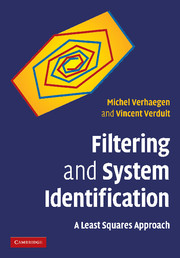Book contents
- Frontmatter
- Contents
- Preface
- Notation and symbols
- List of abbreviations
- 1 Introduction
- 2 Linear algebra
- 3 Discrete-time signals and systems
- 4 Random variables and signals
- 5 Kalman filtering
- 6 Estimation of spectra and frequency-response functions
- 7 Output-error parametric model estimation
- 8 Prediction-error parametric model estimation
- 9 Subspace model identification
- 10 The system-identification cycle
- References
- Index
10 - The system-identification cycle
Published online by Cambridge University Press: 14 January 2010
- Frontmatter
- Contents
- Preface
- Notation and symbols
- List of abbreviations
- 1 Introduction
- 2 Linear algebra
- 3 Discrete-time signals and systems
- 4 Random variables and signals
- 5 Kalman filtering
- 6 Estimation of spectra and frequency-response functions
- 7 Output-error parametric model estimation
- 8 Prediction-error parametric model estimation
- 9 Subspace model identification
- 10 The system-identification cycle
- References
- Index
Summary
After studying this chapter you will be able to
explain that the identification of an LTI model making use of real-life measurements is more then just estimating parameters in a user-defined model structure;
identify an LTI model in a cyclic manner of iteratively refining data and models and progressively making use of more complex numerical optimization methods;
explain that the identification cycle requires many choices to be made on the basis of cautious experiments, the user's expertise, and prior knowledge about the system to be identified or about systems bearing a close relationship with, or resemblance to, the target system;
argue that a critical choice in system identification is the selection of the input sequence, both in terms of acquiring qualitative information for setting or refining experimental conditions and in terms of accurately estimating models;
describe the role of the notion of persistency of excitation in system identification;
use subspace identification methods to initialize prediction-error methods in identifying state-space models in the innovation form; and
understand that the art of system identification is mastered by applying theoretical insights and methods to real-life experiments and working closely with an expert in the field.
Introduction
In the previous chapters, it was assumed that time sequences of input and output quantities of an unknown dynamical system were given. The task was to estimate parameters in a user-specified model structure on the basis of these time sequences.
- Type
- Chapter
- Information
- Filtering and System IdentificationA Least Squares Approach, pp. 345 - 394Publisher: Cambridge University PressPrint publication year: 2007

